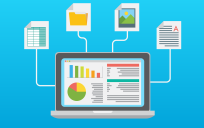In the U.S buildings are consuming 70% of all electricity, up to 50% of which is wasted. By 2025 they will be the largest emitters of greenhouse gases on our planet. Clearly buildings consume a significant amount of energy, but they also produce a lot of data. By analyzing all of this data, agencies can identify areas of operational and financial improvement, increase their reliability and sustainability for future generations, and become a “Smarter Building.”
To help your buildings become “Smarter Buildings” GovLoop and IBM hosted a recent online training to share two case studies of organizations that have successfully integrated their building data to improve decision making. Their stories are pretty telling of the power of your building data.
Speakers included:
- Ken Schwartz, Favrot Professor and Dean, Tulane University School of Architecture
- Frank Santella, Deputy Assistant Commissioner, GSA
- Joseph Phillips, Director, IBM Global Business Services
If you missed the training, you can view the on-demand session here or check out a brief snapshot of each presentation below:
Joe Phillips, Director, IBM Global Business Services:
Phillips kicked off the discussion by defining Smarter Buildings as “well managed, integrated physical and digital infrastructures that provide optimal occupancy services in a reliable, cost effective and sustainable manner.” The idea behind Smarter Buildings is ensuring the “right people have the right information at the right time” to make the right decisions related to their facilities. Phillips breaks down the IBM Smarter Buildings solution into the 3 i’s:
- Instrumented: Billions of signals a year form diverse systems
- Interconnected: Open architecture enabling integration & external data sources
- Intelligent: Enable meaningful actions from analytics and process intelligence
The 3 i’s together lead to smarter buildings – higher performance, lower costs, increased efficiencies, and more productivity. Further, Phillips discussed the analytics and feedback loop which captures you real-time building data, stories in, integrates and analyzes it to provide corrective actions and then creates dashboards for full transparency of the progress you are making.
Ken Schwartz, Favrot Professor and Dean, Tulane University School of Architecture
During his presentation, Dean Schwartz shared Tulane University’s story to become a Smarter Building. Following Hurricane Katrina in 2005, Tulane University was devastated, with many comparing it to a “war zone.”As leaders looked at rebuilding, a primary focus was creating more sustainable infrastructure to lower costs and the University’s carbon foot. More importantly, as a teaching school, they wanted to show their students ways to become more sustainable. Although just beginning, and expecting the large project to take another five years, Dean Schwartz shared some of their goals:
- Use a fraction of its current resources
- Create a building that monitors itself (Richardson Memorial Hall)
- Supports the school’s “culture” and community outreach programs.
Dean Schwartz noted that becoming a “Smarter Building” isn’t easy as there are many cultural hurdles to overcome. However, as he said, “cultural barriers are difficult to overcome, but the incentives outweigh them”
Frank Santella, Deputy Assistant Commissioner, GSA
GSA is targeting 200 of their most energy intensive buildings in GSA, which represent 75% of total energy use. Santella broke down GSA’s Smart and Sustainable buildings strategy into three parts:
- Buildings: they created “open” standards for all buildings controls purchases
- People: Organizational changes including training for technology/security/management
- Technology: Enabling data driven buildings via BuildingLink program.
The BuildingLink program is about breaking down silos (literally) and converging all of their buildings into one common and integrated system. This involves normalizing the data so systems can “talk to each other allowing for better data analysis. Although this is a large undertaking, Santella noted that doing nothing was not an option as becoming a “smarter buildings” is about catching up with reality and remaining competitive and sustainable.
I encourage you to view the on-demand session here for more detailed information on how Tulane University and GSA became Smarter Buildings.
Check out more resources here:
- White paper: Do You Know What Your Building Data is Telling You?
- Video: IBM and Tulane Usher in a New Era for Smarter Buildings
- Video: Smarter Buildings in Rochester, MN
- White paper: Understanding the IBM Approach to Smarter Buildings
- A C-Suite Guide: How to Create Smarter Buildings and Sustainability
- Strategies and Tactics for Becoming More Sustainable
 |
The IBM Analytics Solution Center (ASC) is part of a network of global analytics centers that provides clients with the analytics expertise to help them solve their toughest business problems. Check out their Analytics to Outcomes group on GovLoop. |




Leave a Reply
You must be logged in to post a comment.